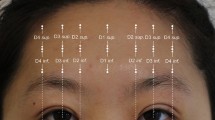Abstract
Background
The procerus is the main muscle across the radix that needs to be operated during rhytidectomy, however, it is unclear whether transecting it can morphologically affect the nose.
Methods
A retrospective study of Asian patients who underwent procerus transection during rhytidectomy in our single institution was performed to assess whether the radix profile had any change postoperatively. The procerus was transected at a plane above the nasion.
Results
Ninety-four patients were included. All of them were female with an average age of 50.7 ± 5.2 years and a mean follow-up time of 7.8 ± 3.2 months. Twenty-seven (28.7%) had moderate horizontal wrinkles preoperatively, and sixty-seven (71.3%) had severe rhytides. Different degrees of wrinkle improvement were seen on 91 (96.8%) patients, and no improvement occurred to 3 (3.2%) patients after procerus transection. The anthropometric measurements on these patients did not find any significant difference between the preoperative and postoperative nasal heights, radix projections, nasal lengths, or nasofrontal angles (all p >0.05).
Conclusions
Procerus transection primary contributes to wrinkle improvement. The morphological change of the radix following this operation is too subtle to be observed. This conclusion should be further verified on large samples as well as on other ethnic cohorts in a long-term follow-up.
Level of Evidence IV
This journal requires that authors 10 assign a level of evidence to each article. For a full 11 description of these Evidence-Based Medicine ratings, 12 please refer to the Table of Contents or the online 13 Instructions to Authors www.springer.com/00266.




Similar content being viewed by others
References
Lorenc ZP, Smith S, Nestor M, Nelson D, Moradi A (2013) Understanding the functional anatomy of the frontalis and glabellar complex for optimal aesthetic botulinum toxin type A therapy. Aesthet Plast Surg 37(5):975–983
Hur MS (2017) Anatomical relationships of the procerus with the nasal ala and the nasal muscles: transverse part of the nasalis and levator labii superioris alaeque nasi. Surg Radiol Anat 39(8):865–869
Knize DM (2009) Anatomic concepts for brow lift procedures. Plast Reconstr Surg 124(6):2118–2126
Koerte IK, Schroeder AS, Fietzek UM et al (2013) Muscle atrophy beyond the clinical effect after a single dose of OnabotulinumtoxinA injected in the procerus muscle: a study with magnetic resonance imaging. Dermatol Surg 39(5):761–765
Monheit G (2015) Neurotoxins: current concepts in cosmetic use on the face and neck—upper face (glabella, forehead, and crow’s Feet). Plast Reconstr Surg 136(5 Suppl):72S-S75
Drolet BC, Phillips BZ, Hoy EA, Chang J, Sullivan PK (2014) Finesse in forehead and brow rejuvenation: modern concepts, including endoscopic methods. Plast Reconstr Surg 134(6):1141–1150
Jones BM, Grover R (2004) Endoscopic brow lift: a personal review of 538 patients and comparison of fixation techniques. Plast Reconstr Surg 113(4):1242–50
Graham DW, Heller J, Kurkjian TJ, Schaub TS, Rohrich RJ (2011) Brow lift in facial rejuvenation: a systematic literature review of open versus endoscopic techniques. Plast Reconstr Surg 128(4):335e-e341
Starkman SJ, Sherris DA (2019) Association of corrugator supercilii and procerus myectomy with endoscopic browlift outcomes. JAMA Facial Plast Surg 21(5):375–380
Steiger JD, Baker SR (2009) Nuances of profile management: the radix. Facial Plast Surg Clin North Am 17(1):15–28
Yu MS, Kim BH, Kang SH, Lim DJ (2015) Combined use of crushed cartilage and fibrin sealant for radix augmentation in Asian rhinoplasty. Plast Reconstr Surg 135(2):293e–300e
Cohen JC, Pearlman SJ (2012) Radix grafts in cosmetic rhinoplasty: lessons from an 8-year review. Arch Facial Plast Surg 14(6):456–461
Tardy MJ, Becker D, Weinberger M (1995) Illusions in rhinoplasty. Facial Plast Surg 11(3):117–137
Tzafetta K, Terzis JK (2010) Essays on the facial nerve: Part I. Microanatomy. Plast Reconstr Surg 125(3):879–89
Blumenfeld AM, Silberstein SD, Dodick DW, Aurora SK, Brin MF, Binder WJ (2017) Insights into the functional anatomy behind the PREEMPT injection paradigm: guidance on achieving optimal outcomes. Headache 57(5):766–777
Macdonald MR, Spiegel JH, Raven RB, Kabaker SS, Maas CS (1998) An anatomical approach to glabellar rhytids. Arch Otolaryngol Head Neck Surg 124(12):1315–1320
Cho Y, Lee HJ, Lee KW, Lee KL, Kang JS, Kim HJ (2019) Ultrasonographic and three-dimensional analyses at the glabella and radix of the nose for botulinum neurotoxin injection procedures into the procerus muscle. Toxins (Basel) 11(10):1–9
Cho GS, Kim JH, Yeo NK, Kim SH, Jang YJ (2011) Nasal skin thickness measured using computed tomography and its effect on tip surgery outcomes. Otolaryngol Head Neck Surg 144(4):522–527
Jayaratne YS, Deutsch CK, Zwahlen RA (2014) Nasal Morphology of the Chinese: Three-Dimensional Reference Values for Rhinoplasty. Otolaryngol Head Neck Surg 150(6):956–961
Kayabaşoğlu G, Dizdar D (2017) An effective technique for nasal radix reduction in septorhinoplasty. J Craniofac Surg 28(8):2143–2144
Funding
No funding was provided.
Author information
Authors and Affiliations
Corresponding author
Ethics declarations
Conflict of interest
The authors have no conflict of interest to disclose.
Ethical Approval
This study was approved by the Institutional Review Board of Plastic Surgery Hospital, Chinese Academy of Medical Sciences and Peking Union Medical College prior to initiation (ethics committee registration number:2019001025). Informed consent was obtained from all patients.
Additional information
Publisher's Note
Springer Nature remains neutral with regard to jurisdictional claims in published maps and institutional affiliations.
Rights and permissions
About this article
Cite this article
Wang, Q., Yue, L., Wang, X. et al. Can Procerus Transection Alter the Radix Morphology and Influence the Nasal Length? A Study of Photogrammetric Assessments and Anthropometric Measurements on Asian Patients. Aesth Plast Surg 46, 342–348 (2022). https://doi.org/10.1007/s00266-021-02435-9
Received:
Accepted:
Published:
Issue Date:
DOI: https://doi.org/10.1007/s00266-021-02435-9




